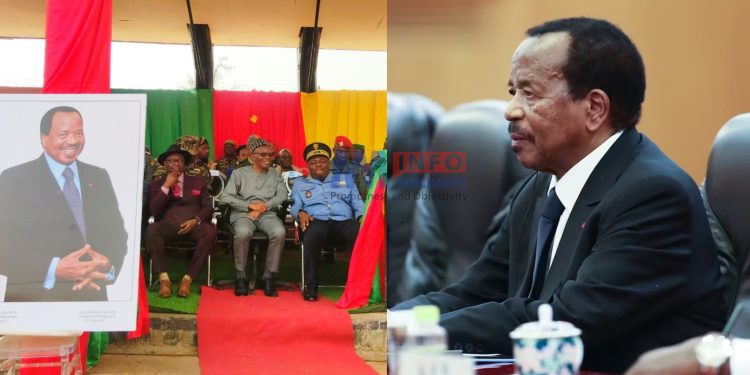Cameroon is currently at a political crossroads, grappling with a unique and disconcerting situation, where a cult personality is being imposed around the president. President Paul Biya, who has ruled the country for over four decades, has not only entrenched his power but is now seeing his image increasingly used as a state symbol.
Lately, there have been controversies with the Administrative authority of the Mvila Division ordering all political parties to march on National Day carrying the effigy of the head of state Paul Biya. The decision of the Senior Divisional Officer has been analysed to mean the effigy of the Head of State is a National Symbol which it is not.
This development underscores the deeply rooted issues of authoritarianism and the cult of personality that have become synonymous with Biya’s regime.
Since assuming office in 1982, Paul Biya has maintained a tight grip on power, often through questionable electoral practices and a lack of democratic freedoms. His longevity in office is a testament to his ability to navigate and manipulate the political landscape, ensuring that any opposition is either subdued or eliminated, the case of the PCRN banned from taking part in the National Day March pass across the country. As a result, Biya’s presence is pervasive across Cameroon, from the halls of government to the streets where his image is omnipresent.
In May 2023 in Bamenda, the image of the head of state was imposed on journalists during the Commemoration of the World Press Freedoms Day. They had to accept if they really want their activity to hold, with administrative authorities present.
The transformation of Biya’s image into a state symbol is more than just an act of political aggrandizement; it represents the erosion of democratic norms and the rise of an autocratic regime that prioritizes loyalty to the leader over the needs of its citizens. This phenomenon is reminiscent of other historical examples where leaders have used their image to foster a cult of personality, thereby solidifying their control and marginalizing dissent.
Critics argue that this move is emblematic of Biya’s desperate bid to immortalize his rule amidst growing discontent and calls for political reform. The symbolism of an image, often associated with reverence and admiration, being forced upon the populace, speaks volumes about the state of Cameroon’s democracy. It suggests a leadership that is out of touch with the aspirations of its people, relying instead on symbols of power to maintain an illusion of stability and control.
Furthermore, this development has significant implications for Cameroon’s future. As the country faces numerous challenges, including economic instability, a persistent Anglophone crisis, and widespread corruption, the focus on venerating a single leader detracts from the urgent need to address these pressing issues. It also raises concerns about the potential for a peaceful transition of power, which is essential for any functioning democracy.
International observers and Cameroonian citizens alike must scrutinise this trend and its broader implications. The international community has a role to play in advocating for democratic principles and supporting civil society in Cameroon, ensuring that the voices of ordinary citizens are not drowned out by the drumbeat of authoritarianism.
In conclusion, the elevation of Paul Biya’s image as a state symbol is a silent reminder of the dangers of entrenched power and the cult of personality. It is imperative that Cameroonians and the global community remain vigilant and committed to the principles of democracy and human rights, working together to envision a future where leadership is accountable, and power is truly vested in the hands of the people, like the late Chairman of the Social Democratic Front Party, Ni John Fru Ndi used to say “Power to the people”.



